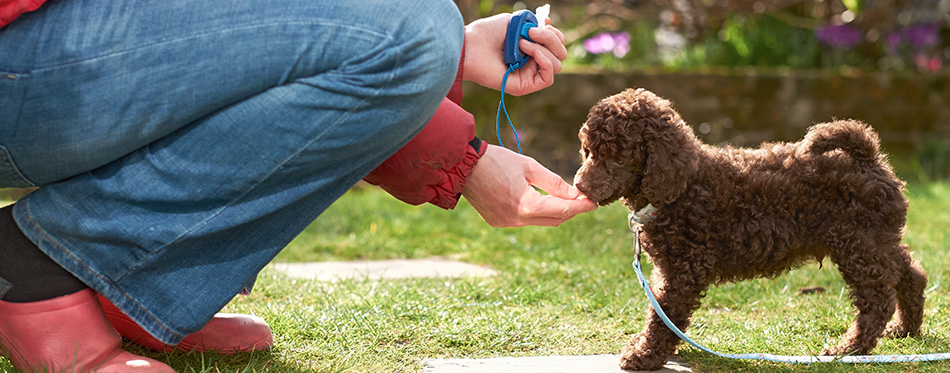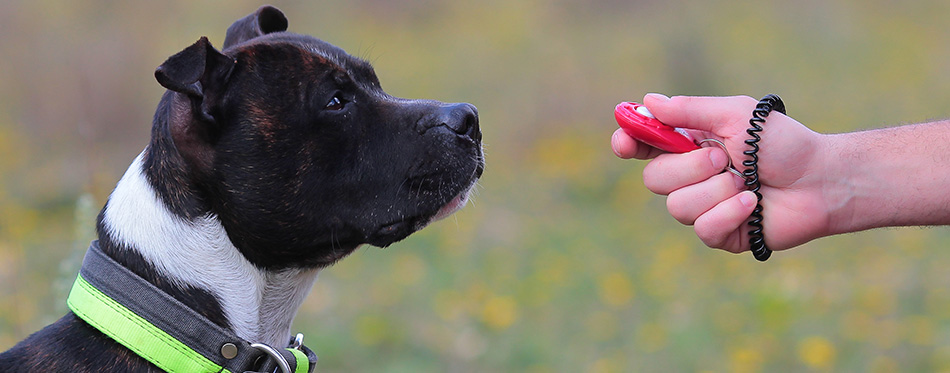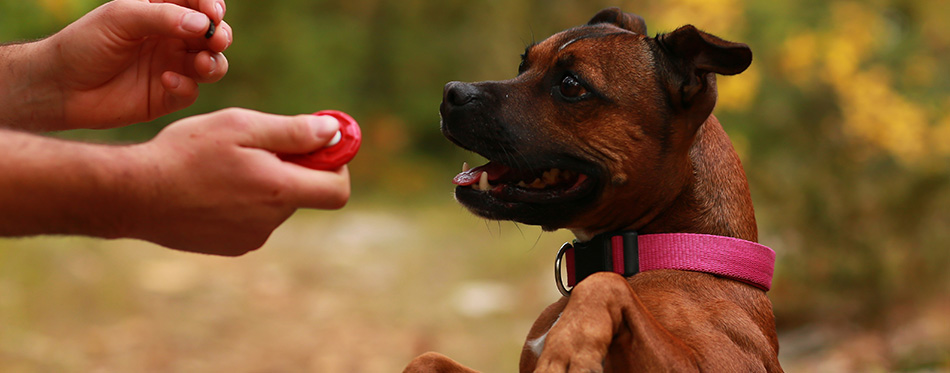Using a clicker to train a dog is one of the more efficient methods of training laid the base responses down. It is easy and effective, and this technique can be used for dogs of all ages ranging from puppies to seniors, as it is never too late to teach an old dog new tricks.
We have put together a clear training guide, starting from the very beginning, on how to use a dog clicker to train your dog in a variety of ways. Clicker training is a favored method among professional dog trainers because of its effectiveness.
How Does Clicker Training Work?
Dog clickers are little plastic boxes sized to fit easily in your hand with a button that presses down on a metal tongue, creating a clicking noise. The idea behind clicker training is to use the clicker each time a dog performs an action in the way it is meant to, specifically the clicker is only to be used at the exact moment your dog follows your instruction correctly.
Dog clickers create a clear and concise communication method, and avoids confusion, as your dog will not need to go off your body language or vocal cues to know whether or not they have done the job correctly.

When Should I Start Clicker Training?
When trying to figure out how to train a dog with a clicker, knowing when best to start can be a big help. Fortunately, clicker training can be used at any time in a dog’s life so long as the dog trainer is committed to the new training technique.
This being said, the best time to start using a clicker is when the dog is a puppy as this has the best chance of success and will more quickly become ingrained in their memory. Knowing how to clicker train a puppy before you get one gives you a leg up when it comes to the actual act of training them.
It is possible to begin clicker training with an older dog, contrary to popular belief it is possible to teach an old dog new tricks, it is simply a matter of perseverance. Older dogs may have more established personalities, potentially making them more stubborn or resistant to new training, but it is not impossible as they are perfectly capable of learning new behaviors.
What are the Benefits of Training Dogs with a Clicker?
Clicker training provides a certain precision to dog training that other training methods tend to lack. There are a variety of benefits to clicker training which we have listed below for you:
- It is an easy sound for dogs to associate with positivity, meaning they will learn what the click means a lot quicker.
- When coupled with positive reinforcement it can be an encouraging way to teach your dog to try new things.
- Clickers are great for teaching your dog to build their attention and focus, there is no messing around.
- The precision of clicker training means it can improve your dog’s timing.
- It can easily pinpoint the moment in which good behavior has taken place, helping your dog to narrow down what day did right.
- Clicker training your dog can help to build confidence if they are fearful or shy.
- It will help you to develop a stronger bond with your dog.
Where to Start With a Dog Clicker
The very first thing you will want to do when starting clicker training is to introduce your dog to the clicker. it is a new and unusual sound and could easily put a dog on edge and so introducing them to the clicker in a calm and familiar setting will provoke a positive reaction and avoid a fearful one.
A common theme throughout your initial clicker training will be positive reinforcement training, this starts immediately with the first few moments of showing your dog this new training device. Keep some dog treats on hand and each time you click it give your dog a treat, this will show them that they are hearing will result in a reward of some kind. Repeat this a few times until your dog seems comfortable with the sound then you know you’re ready to move onto the association training between vocal cues and the clicker noise.
Top tip: For the most effective result, you want to encourage your dog to respond to the clicker at any time. Keep a box of treats nearby and after directly introducing your dog to the sound of the clicker and providing them with their first one or two treats continue going about your day as you would ordinarily.
After 5-minutes or so click the clicker and immediately offer a treat, then continue whatever task you were doing. Several minutes later do the same again, this will teach them but the clicker sound will result in a treat no matter when it happens.
If your dog is particularly fixated on getting the treat out of your hand rather than waiting for the clicker sound, close your hand into a fist with the treat inside and only open your hand when the clicker sounds. This will also teach self-restraint.
How to Implement Training Your Dog With a Clicker
The best way to start any form of training including clicker training is to begin with a very simple command such as “sit”. State your command clearly whilst gently pushing down on your dog’s rear end until they lower their bum to the ground; at the exact moment your dog makes contact with the ground click the clicker and give them a treat.
Repetition is also key, repeat the command and each time your dog’s bum makes contact with the floor click the clicker at the moment of contact and give them a treat as a reward. Always follow a successful command with a treat as a form of positive reinforcement. Dogs are often driven by food and so treats make a powerful motivator.
Dogs are intelligent creatures and often catch on quite quickly, especially with the correct incentive, and so it shouldn’t take too long for them to figure out what is needed of them. You may well find that your pooch only requires a few repetitions of the command before they are doing it of their own volition.
Once your pup has mastered following one command, they will have figured it out enough to learn to follow new commands quicker in the future.
Extra tip for “sit”: If you are struggling to get a response to “sit”, an alternative method for teaching the motion is to take the reward treat and hold it out for them to see it, then slowly move the treat over their head. Quite often the dog will follow the treat with its eyes and naturally sit down.

A Quick Guide on How To Clicker Train Your Dog
For dog owners looking for quick tips and tricks on how to clicker train a dog, here is our quick guide with the key points you will need to proceed with clicker training.
- First, introduce the clicker itself to your dog by clicking it and then providing your dog with a treat to encourage a positive association with the sound.
- Begin with an easy command such as “sit” to test out the new training method.
- Click the clicker at the exact moment that the command is followed correctly. (for example with “sit” – when the dog’s bum touches the ground)
- Repeat these 2 steps until your dog does the required behavior with ease.
- Remember to only click the clicker once, as multiple plates can be confusing.
- Always follow each click with a treat.
Troubleshooting When Clicker Training
The most common problem clicker trainers face is a lack of focus from the dog they are training, so there are a few things you should think about if you’re experiencing this issue.
- Was the clicker introduced properly before starting training?
- Was their association with the clicker built-up fully before starting training?
- Are you rewarding them enough?
- Are you clicking the clicker more than once to signify the task being done correctly?
- Are you switching commands too often?
- Is the training environment over-stimulating and distracting them?
Once you’ve narrowed down what you think the cause might be, try changing that particular detail and continue with the training.
How Long do You Use a Clicker for Dog Training?
The use of a clicker will become instrumental in your communication with your dog when it comes to giving commands. Unlike positive reinforcement with the use of treats which is often phased out in favor of vocal commands, the clicker will be a permanent requirement. this does mean you may want to purchase multiple clickers so that you always have one on hand.
With the most successful clicker training, it is possible to train a dog to respond only to the click and a physical gesture without needing the use of vocal commands at all.
Tips to Get The Best Results
- Keep it Short: Clicker trainers are best keeping training sessions to around 15-minutes or less. This is because animals have a short attention span, and so dragging training out for too long will result in a loss of concentration and bad results.
- You can switch it up: You can work on two or three behaviors at once, but never do less than ten repetitions of a single behavior at a time.
- One click at a time: Only ever click the clicker once when signaling correct behavior. Multiple clicks during a single motion your dog won’t know which behavior you are rewarding.
- The “treat jackpot”: If your dog Successfully completes a particularly difficult task, you can provide them with multiple treats at once in order to promote that bigger effort results in larger food rewards. This is a common technique used with clicker trainers.
The Pros and Cons of Training a Dog With a Clicker
It is worth familiarizing yourself with the pros and cons of this particular training method before committing to it.
Pros
- It is a fast and effective way to teach the basics and can develop into advanced training once the routine is fully established.
- The clear and unchanging sound of a clicker is typically easier for a dog to understand and get used to, compared to the varying sound of a human’s voice.
- Clicker training had yielded some of the best results for response times and effectiveness.
- Clickers can be used to help focus and stimulate an anxious dog’s mind to help them to calm down.
Cons
- You will need to carry a clicker with you at all times in order to be able to make commands, as well as needing treats with you if you have not yet phased them out.
- Timing is essential when clicker training your dog. You need to be sure that the click sounds at the precise moment that the correct behavior is performed.
- Some dogs do not respond well to the sound of a clicker and may find it jarring. This can sometimes be helped by using the clicker in your locket or wrapping it in fabric, but it does not always solve the problem.
Fun Facts about Clicker Training
Clicker training can be used with all sorts of animals including; cats, rats, guinea pigs, chinchillas, birds, rabbits, leopards.
Clicker training is used in several Bear Sanctuaries around the world as a way to encourage cooperation with the bears and is used during administrative tasks such as teeth checking, medication administering, and general animal management.
Clicker training is also used as a method of distraction to occupy animals that are exhibiting signs of stress or anxiety to occupy them and help them to focus their minds. This form of mental stimulation can improve both psychological well-being, which will have a knock-on effect on their physical well-being as well.

FAQs:
Q: Where do I get a dog clicker from?
A: Fortunately, dog clickers are easy to come by and can be found in most pet stores for around $5. If you’re wondering where else you could find a dog Clicker they are available in some veterinarian services, or can even be purchased from many dog training schools or professional trainers.
Q: Why use a clicker instead of my voice?
A: Human voices contain a multitude of nuances that can be susceptible to slight changes caused by a number of factors; cold temperatures, energy level, emotion. A clicker removes the human element and provides a consistent tone that a dog or any animal can easily follow.
Q: Can you use a dog clicker with any dog?
A: Yes, a dog clicker can be used to train any breed or aged dog, it is simply a matter of perseverance, determination, and patience as is any training method. The use of a clicker can simplify the training period and prove to be a worthwhile training method in the future.
One thing you need to consider with clicker training, however, is that not every dog takes to the same training method and you may well find the clicker training is not for your pup. Some dog breeds respond to commands differently than others and may require an alternative method of teaching.
Q: Can a dog clicker be used for potty training?
A: Absolutely, it is recommended that you start clicker training as soon as possible, and seeing as potty training is usually the first port of call, it is safe to assume that this is when your key training method should be introduced to your puppy. Introducing the dog training clicker during this early stage will help you to avoid any confusion in the future.
Q: Do I always have to use a dog clicker?
A: Once you have established this training technique with the use of a dog clicker, you will need to continue the use of the clicker throughout your dog’s life. Considerate it as you would vocal training, your dog has learned to respond to the clicker as they would your voice and so it is your primary method of communication when performing a task. The clicker has become embedded in your relationship with your dog. Clicker training is a lifelong commitment just like any other form of dog training.
Q: Do I always have to give my dog a treat after using the clicker?
A: No. Once they have properly learned what you expect of them and respond to a command well, you can begin to reduce the number of treats you use, eventually phasing them out completely. You can use fusses and positive vocal responses in their place.

